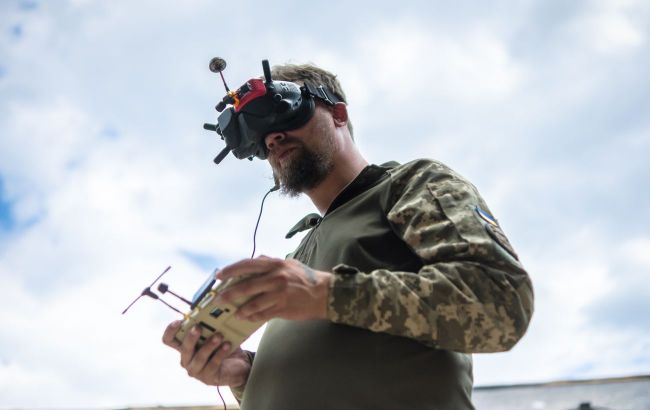'We just have to survive.' How war pushed Ukraine ahead of Europe in military tech
 Soldier with a drone during training as part of the Army of Drones project (Photo: Vitalii Nosach/RBC-Ukraine)
Soldier with a drone during training as part of the Army of Drones project (Photo: Vitalii Nosach/RBC-Ukraine)
Ukraine has made a huge leap in the development of military technologies in a short time. But the frontline demands more and more, and in some categories of drones, the advantage still lies with the enemy. Meanwhile, some manufacturing companies have relocated abroad, while others struggle to hire specialists due to issues with military recruitment centers. How the industry is evolving now – read in the report by RBC-Ukraine.
Key questions:
- Why are European countries impressed by Ukrainian tech innovations?
- In which drone categories does the enemy still have the upper hand?
- What has become a real challenge for our soldiers on the frontline?
- What problems do manufacturers face, and why have some moved abroad?
- What is the future of the drone market after the war?
"I must humbly admit: the production lines already operating in Ukraine and funded by French capital are far more efficient than our own. Today, we have a lot to learn from Ukraine – and we must acknowledge that," said French Defense Minister Sébastien Lecornu in June 2025, announcing a new drone production partnership with Ukraine.
Lecornu is right. According to Yevhen Rvachov, founder of SkyLab, Ukraine is currently the only country in the world to have launched so many new tech products from almost nothing in just 3.5 years.
"And it's not just drones. Ukraine has established transparent communications, military management systems, training centers, and has helped expand the defense industry. There are countless training courses – tactical medicine, UAVs, engineering, weapons handling, and land navigation. We realized no one else would do this for us. We are the only country in the world in this situation, and we made it happen. A country forced into such conditions will survive simply because evolution demands it," he says.
Still, the needs of the frontline are enormous, and the market faces challenges. RBC-Ukraine spoke with leading tech companies to find out what’s happening in this sector right now.
"You’re in a country that makes more drones than anywhere else in Europe"
Today in Ukraine, beyond various types of drones, companies are manufacturing a wide range of robotic systems. These include machines that evacuate the wounded from the battlefield, remotely lay and clear mines, and assist in offensive and defensive operations.
Ukraine is ramping up production of robotic systems and deploying full-fledged robotic units within combat brigades of the Armed Forces along the front line, as Defense Minister Rustem Umerov wrote earlier this year. Importantly, according to him, the main suppliers are leading Ukrainian companies.
"It's hard to imagine how long it would take to develop something like this in Europe," says a representative of a top Ukrainian tech company that also produces combat drones, speaking to RBC-Ukraine.
"I once spoke with a colleague from Spain. He said that something we managed to implement in a year would've taken them about five. In Europe, they'd spend three years thinking it through, five years developing it, and then wait for licensing. We complain about our bureaucracy, but is it really any better in the EU? We do it fast - because there's no other choice. War demands bold and rapid decisions," he says.
He also recalls a visit last year from a representative of a Western company who came to pitch a new development.
"He showed off this 'cutting-edge' tech, convinced it would impress us. But my colleagues politely stayed quiet - they'd seen that tech back in 2022. I said to him, 'Look, you are in a country that makes more drones than anywhere else in Europe.' After traveling around a bit more, he eventually admitted they should be learning from us, not the other way around,' the developer adds.
Still, he emphasizes that having many companies doesn't mean the frontline's needs are fully covered - it would be a big mistake to assume that just because we now have a lot of companies, the main needs of the army are being met.
"There are always problems and challenges - new ones come up constantly. Sure, in 2022, we lacked literally everything. But even now, there's still so much we need. The situation changes every month, and we constantly have to invent and adapt," he says.

Reconnaissance and strike ground robotic systems at the exhibition of Ukrainian weaponry (Photo: Vitalii Nosach / RBC-Ukraine)
"We're behind in FPV, and no one believed in fiber optics in Ukraine at first"
Russia's full-scale invasion of Ukraine caught Yevhen Rvachov in his hometown of Balakliia, Kharkiv region.
He fled the already-occupied city to Kharkiv, where he began helping the military with radios, communications, small drones, various GPS tag types, and anything else he could get his hands on. Later, he moved to Kyiv, where it was both safer and more logistically stable. That's how SkyLab was born - a company focused on developing high-tech robotic systems and aerial drones.
SkyLab's first product was the Shoolika mk6 - a strike drone capable of carrying up to 6 kilograms, operating via multiple communication systems, and flying despite Russian electronic warfare (EW). Then came ground kamikaze drones based on basic remote-controlled cars carrying 1.5 kg of explosives and intended for one-way missions. Next were larger drones, tailored for precision operations by special units.
In 2023, SkyLab began developing its flagship product: the Sirko ground robotic system and its equipment. Today, it is officially in service with Ukraine's Defense Forces and supplied under government contracts.
"The new version has a range of over 50 kilometers. It uses several types of communication, including satellite. The offline office employs 47 people, and with contractors, about 150 people are involved in making these drones," says the company's founder.
Different types of drones are developed by different teams.
"It’s like building a car versus a boat," Yevhen explains, "The Shoolika is a bomber drone, unimpeded by terrain but affected by factors like wind, humidity, payload weight, and Jamming/Spoofing (tech that emits false signals to confuse drones - Ed.), coordinate spoofing, or complete signal suppression."
 FPV drone connected by a fiber-optic cable (Photo: Vitalii Nosach / RBC-Ukraine)
FPV drone connected by a fiber-optic cable (Photo: Vitalii Nosach / RBC-Ukraine)
"A wheeled drone is basically an electric vehicle running on all-wheel drive electric power. It's fully remote-controlled," explains Rvachov.
Technology in war is evolving constantly and rapidly, notes Dmytro Babenko, co-founder of VYRIY.
"Just two years ago, FPV drones weren't so widespread on the front. They were made from standard Chinese components and used default frequencies, but that no longer works. At our company, we've switched to mostly localized Ukrainian parts. That's important both for security and for customizing frequency, tactical, and technical specs," he explains.
Another shift has been the introduction of autonomy modules. According to him, 2024 was the year of target guidance system development, but eventually that technology went slightly off course and never became a gamechanger or widely used on the front. In 2025, having learned from last year's mistakes, Ukrainian companies are expected to offer new battlefield tech.
Another emerging trend: system integration and merging Ukrainian reconnaissance drones with FPVs, pairing strike drones with signal-relay drones, and other combinations.
"AI-based autonomy systems are relatively cheap and quick to build. But earlier, some of the technological solutions proposed by Ukrainian developers were going in the wrong direction. Now we're gradually turning the ship around. We expect to see a wave of different autonomy systems - both ours and the enemy's," say VYRIY engineers.
Despite diverse technologies, Ukraine is lagging behind Russia in FPV drones, both in tech and sheer numbers. An anonymous source in the field says:
"FPV drones are creating real terror for our guys on the front. Something needs to be done,” says the engineer.
Enemy drones are also becoming increasingly dangerous for Ukrainian cities, as Russia continues to improve them.
"Our robotic systems are great, but we're still lacking a domestic alternative to Chinese Mavics. And Mavics can't perform the tasks they once did. As far as I know, there aren't any major developments in that direction right now,” he adds.
One crucial area is the development of fiber-optic drones. This tech has existed before, but Ukraine didn't believe in it, Babenko says.
"As a result, we fell behind in this area and are now playing catch-up. But over the past year, we've significantly sped up. I believe that by the end of the summer, we'll reach the scale needed to compete with Russia."
Fiber-optic drones are a serious challenge for the military. They can't be jammed by electronic warfare, which allows Russians to conduct recon and correct artillery even in dead zones. They don't emit signals, making them harder to detect or intercept. Traditional countermeasures don't work well against them.

Ukrainian soldier with an FPV drone (Photo: Vitalii Nosach / RBC-Ukraine)
Outflow of companies abroad and problems with recruitment centers
After more than three years of the large-scale war, manufacturers observe a wave-like market dynamic. There have been both significant growth and declines. There is also an outflow abroad - not just individual employees leaving, but entire companies relocating. This doesn't happen for good reasons, believes Yevhen Rvachov.
About 20% of the SkyLab staff are internally displaced persons from Zaporizhzhia, Dnipro, Kharkiv, and Mykolaiv. These are people who have drastically changed their lives, have children, rent apartments, and are starting everything from scratch.
"If, God forbid, the moment comes when we have to cut staff - due to lack of government orders or decisions at the ministry level - I simply won't be able to go out and tell these people: ‘Sorry, we have layoffs.’ These people are important to me. We supply 100% of our drones exclusively for the army's needs. We haven't sold a single drone or component to the civilian market. And if people need to be laid off, of course, I will be looking for various export opportunities," he says.
The co-founder of VYRIY, on the other hand, believes the drone market in Ukraine is just forming. He does not see company relocation as a widespread trend. "Yes, such stories exist, but I wouldn't call it a tendency," notes the interlocutor.
"A very correct decision made this year was to allocate money for procurement directly to the brigades. The military on the ground know better what they need and work with different manufacturers. Essentially, supply and demand, the presence of many buyers and sellers, is what shapes the market,” says Dmytro Babenko.
Last year, most companies worked on government contracts. This year, many did not receive enough of such orders. As a result, they are forced either to close or become contract manufacturers for companies that do have government orders, adds the co-founder of VYRIY.
At the same time, some companies that Yevhen Rvachov knew back in 2022 are no longer in Ukraine. They moved abroad and now pay higher taxes and salaries there. That, in turn, drives up the cost of drones. Because of this, drones for the military also become more expensive, says Yevhen.
"For example, there is a drone battery. Unfortunately, a Ukrainian company cannot buy it directly from China. It's no secret that they have to do it through Europe. A company in the EU takes its percentage. In 2022-23, this went smoothly. But now something is happening in the financial market, and it has become extremely difficult even to transfer funds,” explains Yevhen about the problem.
 Ground robotic complex Sirko S1, manufactured by the Ukrainian company SkyLab (Photo: provided to RBC-Ukraine)
Ground robotic complex Sirko S1, manufactured by the Ukrainian company SkyLab (Photo: provided to RBC-Ukraine)
The state, he says, has done a lot for such procurements. There are all the necessary customs codes, preferences, and accelerated procedures at the border. But the final cost of the product for Ukraine is higher.
For Estonia, the Chinese battery costs the same. But brokers, warehouses, logistics - these are expenses in euros that have to be paid. Thus, the final product becomes tens of times more expensive, and companies still need to offer a good and reasonably priced proposal to the Defense Procurement Agency, while remaining useful to the military.
Another problem is that SkyLab cannot hire a good specialist if he has not updated his data at the military recruitment center. The law forbids it. And in general, finding people suitable for this position is very difficult.
"There is a person devoted to their work, who has spent their whole life in IT, but I cannot hire them. By the way, the state has done everything so that we can quickly reserve people. But often, the human factor in the recruitment center itself becomes an issue. Sometimes I have to go there hand-in-hand with the person and explain that this is an important specialist. Sometimes it's hard to explain. When our specialist goes to the center, we want him to come out of there," says Yevhen.
It often happens that companies help the army in a critical moment, but then leave the military market, moving to agriculture or other industries. They close down because they can't handle competition, and also because in 2022-23, they grew too quickly, took large government contracts, and now lack management for scaling. Meanwhile, the needs of the front have not disappeared, says a representative of another technology company.
"Focus on what you do best"
What causes more problems at the front: quantity or quality? There are many drones, but many of them need reworking, says Dmytro Babenko.
"Therefore, I would say our problem is with the quantity of quality drones. This issue is being addressed, including through the launch of the DOT-Chain Defense System and tenders by the Defense Procurement Agency,” Babenko notes.
 Sea drone Magura (Photo: Vitalii Nosach / RBC-Ukraine)
Sea drone Magura (Photo: Vitalii Nosach / RBC-Ukraine)
Previously, he says, due to inefficient procurement procedures, drones were often delivered to the front that didn't fly. And often not because they were bad, although that happened sometimes, but because of the time lost. When those UAVs were purchased, the conditions at the front were different; now the conditions have changed, and the drones delivered no longer fit and need to be replaced.
"But how do you replace them once they're already bought? That's why working directly with brigades and units, who are the end users, is the right approach. It may be more difficult for manufacturers, but there's no other way for now. Speaking from my own experience: working directly with the military, we have examples where our drones are used in combat just days after order acceptance and delivery,” he says.
Will the market fall when the war ends? Of course, all of this exists while there is demand, says Yevhen. But even now, companies need to think about what they will do when the demand for drones disappears. Everyone should plan their strategy.
"At SkyLab, we clearly understand where the product will go if the need changes. You need to think ahead about strategy and which market segment to occupy. I believe: focus on what you do best. Then the market space, the people, and the resources will come. If you focus on your core strengths, everything else will follow,” emphasizes Yevhen.

